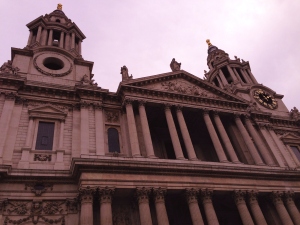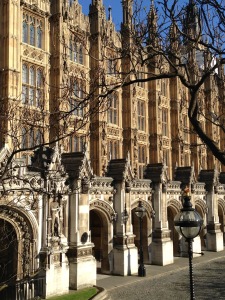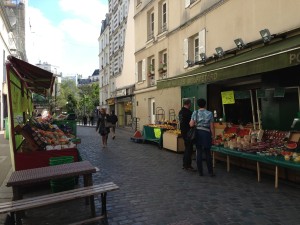It’s Labor Day, a time when my family confronts our many unfinished projects of the summer. No better time, then, than to resume new posts on Wild Trumpet Vine. Some, like this one, will look back to last spring, while others will be more timely. So now, back to our leaving Paris for London in April.
**********************************************************
Getting to the train and on board was by far the most stressful segment of our trip. The night before, we’d asked the hotel concierge to arrange for a taxi to the Gare du Nord at 9 AM. Our train was to depart shortly after 10. When we trooped down with our bags in tow, the friendly concierge was surprised to see us. The taxi was to arrive at 10 AM, just as we’d asked. Uh oh.
The concierge called for expedited service. A tense twenty five minutes ticked slowly by before we were on our way.

The enormous Gare du Nord was more congested and confusing than I had ever seen it. Lines for the Eurostar were snake-like and slow-moving. When at last we made it to the area leading to customs, an attendant pointed us toward a counter to fill out a boarding card. Did we each need to fill on out? He wasn’t sure. Time was short, so we completed one for the family, as I remember doing on overseas flights. Although, oddly, come to think of it, we had received no boarding cards on our Air France flight. Arriving in Paris, we had breezed through customs with barely a pause. It was like sailing through the Easy Pass lane in a New Jersey toll plaza.
Further along, another attendant asked for our boarding cards. And no. We all needed one. Didn’t we see that it said “Name” and “Passport Number”? How can that apply to an entire family? The unexpressed question being: Are you idiots? Maybe. But H and I both remembered that rather archaic wording on the cards at the airlines: To be completed by Head of Household, or something to that effect. We rushed back to grapple with the boarding cards, again. Of course, there was the typical pen problem. Those anchored to the counter (on not-quite-long-enough chains) were running out of ink. In search of working pens, I rummaged awkwardly through my purse, which was stuffed beyond full. H stared at me in exasperation. Why is he not expected to have instantaneous, magical access to some writing instrument, I wondered. Perhaps because we were in such a rush, the requested information seemed ridiculously detailed. Address in London? Are you kidding? Anyone have the hotel address? We muddled through.
We were flustered and on edge as we approached the customs agent, who sat scowling fiercely in his little glass box. Why, exactly, were we going to London? What was the purpose of our trip, he asked ominously? He grilled H and me first, then turned a laser focus on our daughter. Apparently he expected her to cave and reveal that our trip had some vile, nefarious goal. Sight-seeing? Reeaally? And what sights do you wish to see? You want to compare London and Paris? Indeed? To what end? At last the agent tired of the interrogation, and waved us on, still hostile but bored and dismissive. With relief, we made our way down to the platform, where the train was, thankfully, still waiting. It was due to depart in seven minutes.
Once on board the uncrowded train, a welcoming, quiet calm enveloped us. Whew! Only after we were settled did I look at my ticket and see, written there in bold print: Arrive at least 30 minutes prior to departure for check-in. We had completely forgotten that helpful suggestion. Because we had printed our tickets at home, the need to allot time for check-in had escaped us. Had we known how extremely close we were cutting it, we really would have been worried.
The journey from Paris Nord to London’s Saint Pancras was smooth, quick, and uneventful. We were soon served a pleasant breakfast by polite, soft-spoken attendants. In less than a half hour, we were gliding silently through the tunnel. A half hour later, we emerged into sunshine and the same gently rolling fields of brilliant gold that we had seen in France. Rapeseed, I learned, grown for its oil. An unfortunate name for something so pretty. The entire trip took about two hours and fifteen minutes. It was vastly quicker and more efficient than in the old days of train, boat and train, each segment prefaced by a long wait in a smoky departure lounge.
My family and I wouldn’t have considered adding London to our itinerary on this trip if it hadn’t been such a convenient train ride from Paris. But I was glad I lived through those old days and had the memories to show for it. Glad I had the chance, with my fellow middle-school aged friends, in 1975, to cross the Channel by slow ferry. See European Vacation, ’75: Crossing the Channel. I had described that crossing in my travel journal as a highlight of the trip. Had we traveled then on a sleek, fast train, there would have been less opportunity for adolescent adventure. While the Eurostar served my family’s purpose perfectly on this recent trip, I’m happy it didn’t exist on my very first European vacation.



















































